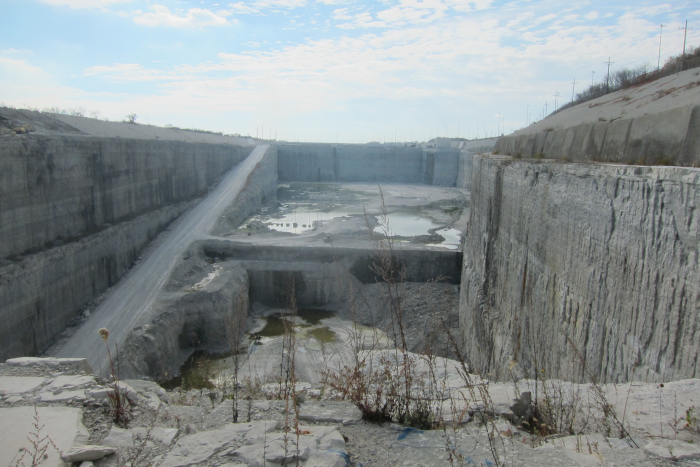



マクック貯水池はイリノイ州ラグランジにある 100 億ガロンの貯水池です。建設が完了すると、シカゴ都市圏水再生地区 (MWRDGC) が貯水池を所有し、運営します。貯水池は 2 段階で建設され、第 2 段階のエリアから岩石を採掘している間に第 1 段階が完全に機能するようにします。主な構成要素には、表土遮断壁、配水トンネル、メイン トンネル、排水ポンプ、ゲート、バルブ、水圧構造、帯水層保護、および曝気システムが含まれます。このプロジェクトは、シカゴと 36 の郊外で洪水や水路汚染を引き起こし、500 万人に影響を及ぼす可能性のある、合流式下水道 (衛生および雨水) のオーバーフローの対策に役立ちます。
自動データ収集システム (ADAS) は、現場の 13 台のリモート モニタリング ユニット (RMU) にレポートする機器のネットワークからデータを収集しています。監視対象の機器には、時間領域反射計 (TDR)、インプレース傾斜計 (IPI)、バイブレーティングワイヤ ピエゾメーター (VWP)、伸び計などがあります。RMU 1 から 13 はそれぞれ、Campbell Scientific AVW200 および TDR100 を介して機器を読み取り、Campbell Scientific CR1000 および CR800 データロガーにデータをローカルに保存します。
以前のデータ収集手順には、地区の地質工学チームが現場を訪問し、ハンドヘルド PC を介して各 RMU からデータを手動でダウンロードすることが含まれていました。その後、ハンドヘルド PC は地区事務所に返却され、ネットワーク外のコンピュータにアップロードされ、データはスキャンのためにエアギャップ マシンに転送されました。その後、データはネットワークに転送され、Canary Systems の MultiLogger データベース コンソール ソフトウェアを介してリモート データベース サーバーにアップロードされました。その後、.dat ファイルは Excel 形式に変換され、新しいデータは各 RMU のマスター スプレッドシートに手動で追加されました。その後、データのグラフィック表現が手動で更新され、新しいデータが取り込まれました。
この方法は、データに定期的にアクセスして潜在的な障害を早期に警告する能力を無効にするため、非効率的でした。
Canary Systems には、以下を提供する任務が課されました。
- ワイヤレスでのデータ転送とアクセス方法
- 分析のためのグラフィカルなデータ視覚化の自動化方法
- 新しい基地局用の新しい自動音声視覚早期警報システムの設計と設置、重要な懸念事項の監視
- 追加のバイブレーティングワイヤクラックメーターの統合
このプロセスには、RMU にインストールされている既存の Campbell Scientific 電子機器を統合するために MultiLogger ソフトウェアを使用して構成された、ホストされたデータベース サーバーへの 6 時間間隔と 5 分間隔での自動データ転送用のセルラー モデムのインストールが含まれていました。
ホストされたサーバーには、Canary Systems の MLWeb ソフトウェアを使用して、エンド ユーザー向けの Web サイトがセットアップされました。この Web サイトには、計器の相互にリンクされた航空写真と断面図が含まれており、最新のデータと履歴データが表示されます。ユーザーは、同じグラフに表示する複数の計器を選択したり、グラフィカル出力の時間枠を調整したりできます。
タイムリーなデータ削減と処理を支援するために、MLWeb ソフトウェアを使用してカスタマイズされた計算、グラフ、レポートを作成し、校正係数や補正係数を含む現場からの生データを変換して視覚化しました。例:
- 降水量を第2のY軸にプロットしたピエゾメーターデータの相関関係
- 累積降水量を含む1時間ごとの雨量計データ
- 傾斜計データ(増分および累積変位値を含む)(採掘シーズンの停止期間中に発生する傾斜計センサーの標高の変化を組み込むことに特に注意が払われました。)
- 各TDRの深さに対する相対反射率のグラフ
- 伸び計データ(時間に対する増分変位を含む)
自動化された検証ルールは、爆発や自動車や機関車の傾斜センサーの地面の振動などによって引き起こされる誤った高値や低値の読み取りをフィルタリングし、データベース内の元のデータを保持します。
変化率のしきい値を含むしきい値に到達または超過したデータは、Web ポータルで赤で強調表示され、自動アラームと通知により、トリガー機器と過去 5 回の読み取り結果が主要なスタッフに電子メールで送信されます。新しく設計された早期警告システムにより、すぐ近くにいる乗組員に即座に音声と視覚によるアラームが提供されます。